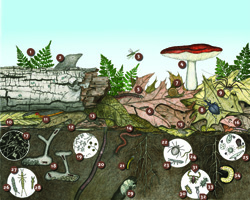Know Soil, Know Life
Click the image below for a pdf preview of the book! .
 Think of all the things we need most for daily living: food, clothing, shelter, water. Have you ever considered how each of them, in turn, depends on soil—that without soil, in fact, there would be no life?
Think of all the things we need most for daily living: food, clothing, shelter, water. Have you ever considered how each of them, in turn, depends on soil—that without soil, in fact, there would be no life?
Targeted to high schoolers and college students in introductory courses, this 206-page book tells the story of soil through engaging, accessible language and hundreds of full-color photos and illustrations. It begins with a chapter that challenges readers to view soil not as inert “dirt”, but as living material that carries out critical functions for the environment and for people.
Soil filters our drinking water, for example, and supports the plants that feed, clothe, and shelter us. “Without soil we’d be hungry, naked, and homeless,” quips co-editor Clay Robinson, a New Mexico soil scientist who has taught tens of thousands of school kids about soil as the persona, ‘Dr. Dirt.’ “Also, breathless,” he adds, “because it’s the plants growing in soil that produce our oxygen.”
Know Soil Know Life then takes readers through a traditional sequence of soil science topics, including soil chemistry, biology, and classification, before drawing a direct line between people and soils once again. In chapter 8, “Soil and Society,” the authors describe the impact of soil on human endeavors ranging from art to warfare. The chapter also details soil’s role in the collapse of past civilizations, such as the Easter Islanders, and modern-day concerns like desertification and deforestation.
Lindbo, Robinson and the other contributors to Know Soil Know Life are all members of the Soil Science Society of America’s K-12 education committee: a group of college professors, professional soil scientists, and educators who’ve devoted themselves to sharing soil science as widely as possible. Formed in 2006, the committee’s first book project was a text for 4th graders, SOIL! Get the Inside Scoop, which goes with the traveling soils exhibit for kids, “Dig It! The Secrets of Soil” (now showing at the Bell Museum in Minneapolis, MN).

The book concludes with a chapter on the soil science careers available in research, land management, education, and environmental consulting—careers that many of today’s soil scientists didn’t learn about until they were almost through school, Robinson says. This includes Deb Kozlowski, a soil scientist and K-12 art teacher who co-edited Know Soil Know Life with Robinson and Lindbo.
Image Credit: James B. Nardi
View the online accompanying Educators Guide
Purchase Know Soil, Know Life



